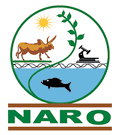PGRC | Genebank
Uganda has a rich diversity of crops and a good landrace collection is maintained at the Uganda National Gene bank (UNGB).
In the National Genebank, seeds of species that can be dried to very low moisture content and kept under frozen conditions (referred to as orthodox seeds) are stored in freezers at -20°C. Under such conditions the seed can stay alive for up to 50 years. At the Genebank over 5,000 accessions are being conserved in both the active (short term storage 5°C) and base (long term storage -20°C) collections. The Genebank ensures that seed placed in storage are of the highest quality and achieve maximum longevity. The seed are occasionally regenerated to ensure their genetic integrity is maintained.
In the National Genebank, seeds of species that can be dried to very low moisture content and kept under frozen conditions (referred to as orthodox seeds) are stored in freezers at -20°C. Under such conditions the seed can stay alive for up to 50 years. At the Genebank over 5,000 accessions are being conserved in both the active (short term storage 5°C) and base (long term storage -20°C) collections. The Genebank ensures that seed placed in storage are of the highest quality and achieve maximum longevity. The seed are occasionally regenerated to ensure their genetic integrity is maintained.
Species whose seed cannot survive desiccation and very low temperature levels (referred to as recalcitrant) and are conserved in the Botanic gardens as live collections. The germplasm held is available for different users on request.
Documentation and Information Networks for Plant Genetic Resources
The Genebank has developed data capture forms as a step towards organized documentation, and in addition utilizes the SESTO Genebank data management tool for information management on stored and conserved material PDF .
The Genebank has developed data capture forms as a step towards organized documentation, and in addition utilizes the SESTO Genebank data management tool for information management on stored and conserved material PDF .
Documented PGRFA
|
Pennisetum glaucum |
Cajanus cajan |
Garcinia buchananii |
Arachis hypogaea |
|
Sorghum bicolor |
Cicer arietinum |
Carissa edulis |
Gossypium hirsutum |
|
Sesamum indicum |
Cleome gynandra |
Eriosema shirense |
Pisum sativum |
|
Oryza sativa |
Amaranthus |
Parinari curatellifolia |
Vigna unguiculata |
|
Chenopodium quinoa |
Solanum melongena |
Landolphia dawei |
Phaseolus vulgaris |
|
Eleusine coracana |
Vigna subterranea |
Rhus vulgaris |
Vigna radiata |
|
Abelmoschus esculentus |
Zea mays |
Acacia senegal |
Glycine max |
|
Panicum maximum |
Chloris gayana |
Pennisetum species |
Cucurbita maxima |
|
Brachiaria ruziziensis |
Hyparrhenia rufa |
Setaria anceps. |
Capsicum frutescens |
Following the adoption of the Second Global Plan of Action (Second GPA) on Plant Genetic Resources for Food and Agriculture (PGRFA) by the FAO Council in November 2011, the Commission on Genetic Resources for Food and Agriculture (Commission) adopted at its 14th and 15th Regular Session a list of 63 indicators and a reporting format for monitoring the implementation of the Second GPA http://www.fao.org/wiews/data/domains/monitoring-framework/en/. This also includes data on all stored collections in the Uganda National Genebank under priority activity of EX-SITU CONSERVATION https://www.fao.org/wiews/data/organizations/en/?instcode=UGA528#details .
The Centre spearheaded the development of the National Information Sharing Mechanism of PGRFA in Uganda. This exercise involved gathering and assembling PGR information from national agricultural institutions for purposes of updating the 1996 country report on the status of the PGRFA in Uganda.
Registered/Participating Stakeholder Institutes can also access and update their Institutional Information through http://www.fao.org/pgrfa/.
Multilateral System species declaration
A total of seven hundred and sixty (760) accessions have been confirmed as materials that are automatically in the multilateral system. These materials can be accessed at http://www.fao.org/plant-treaty/areas-of-work/global-information-system
Digital Object Identifiers
With request from germplasm users, the International Treaty on Plant Genetic Resources for Food and Agriculture (ITPGRFA) set up a system referred to as the Global Information System (GLIS) that assigns Digital Object Identifiers (DOIs) to Plant Genetic Resources (PGRs). The purpose is to assign a permanent, globally unique identifier to the materials to facilitate data exchange and information accumulation. As you know, DOIs have been initially designed for the publishing sector, nevertheless, now they are assigned to a wide range of things and they still have strong ties to publishing. Such ties are very useful, though, because DOIs offer advanced services that allow GLIS, for instance, to automatically identify and make available publications and datasets referencing PGRs. Additional details are available at http://www.fao.org/plant-treaty/areas-of-work/global-information-system
The Uganda National Genebank has so far assigned DOIs to 65 accessions of Sorghum, Bean, Finger millet, Cow peas and Ground nut. The assignations of DOIs to the Provider’s and to the Recipient’s material allow to differentiate the materials when they are transferred from one collection to another to avoid duplication, as well as to properly attribute any research results that may be produced.
SAFETY DUPLICATION OF SEED IN SVALBARD SEED VAULT, NORWAY
The International Treaty on Plant Genetic Resources for Food and Agriculture (ITPGRFA), adopted in 2001, is a global response to promote the conservation of plant genetic resources. The objectives of the International Treaty are conservation and sustainable use of all PGRFA and the fair and equitable sharing of the benefits arising out of their use, in harmony with the Convention on Biological Diversity, for sustainable agricultural and food security.
In accordance with Treaty, the Government of the Kingdom of Norway established the Svalbard Global Seed Vault to provide a safety net for the international conservation system of plant genetic resources, and to contribute to security the maximum amount of plant genetic diversity of importance to humanity for the long-term in accordance with the latest scientific knowledge and most appropriate techniques.
The Uganda National Genebank deposits some of its seed samples at the Seed Vault.

